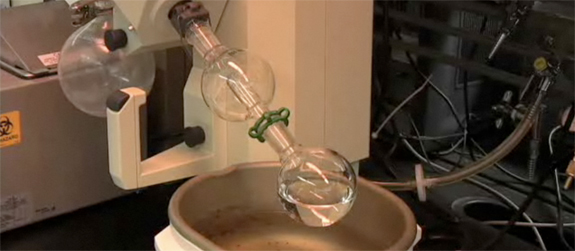Reducing Bumping on the Rotovap
by
The bump guard lesson is usually learned one of two ways: A) someone teaches you, or B) someone doesn’t. The former is ideal and you may have no idea how lucky you are. The latter looks like this…
As an undergraduate, my research project involved the multi-step synthesis of a 20-membered macrocycle. Since there were a number of steps, I performed the first reaction several times in order to stockpile a large amount of material. The first step was particularly unnerving since it required the use of 95% dry sodium (which I could feel warming it’s way to ignition in the air as I weighed it…) and the scary floor-to-ceiling solvent still.
After performing the reaction several times, I finally had enough compound to move forward. I combined all of the material and ran a large silica gel column to purify it. Given the scale, the compound eluted over a number of fractions and in a substantial amount of volume. As I added fraction after fraction to the round-bottom, I realized that it was getting pretty full. But, “what difference would a couple more fractions make?….” So I poured them in.
Eager to move on to the next step, I put the round-bottom on the rotovap (sans bump guard) and turned on the vacuum. Moments later, my world was in slow motion as I watched the explosion of my solvent out of the round-bottom and over to the collection flask. It came splashing to rest in a pool of unknown liquid in the collection flask. I stood there numb – staring at my compound like a child watching their goldfish being flushed. Although I tried to recover the compound from the collection flask, it was too dirty and too risky to carry forward in such a long synthesis. This, of course, meant I was back to square one.
Lesson learned.



Gmeira
wrote on February 23, 2011 at 5:13 pm
same just happened to me but thankfully the bump guard caught it!!! whew